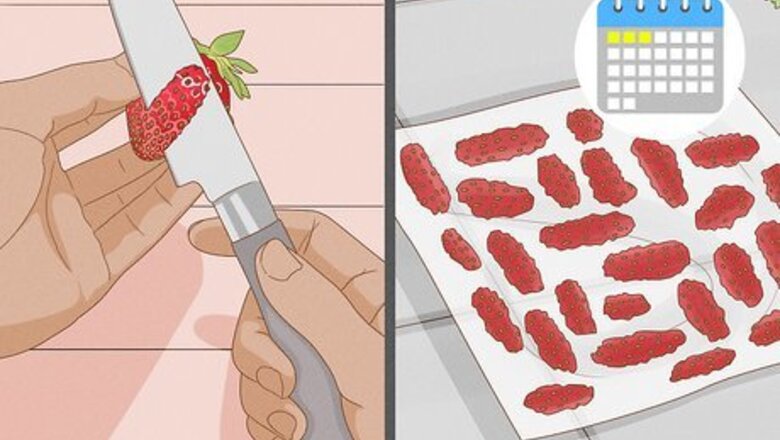
views
- Peel the top layer of strawberry skin that contains the seeds. Dry the berry peels in the sun for 2-3 days and then rub off the seeds.
- Set the seeds in the fridge for 1 month. Then, lay 2-3 seeds in each cell of a seed tray filled with seed starter mix.
- Place the tray in a sunny spot and set plastic wrap over the top. Then, wait for the seeds to sprout in 1-6 weeks, and transplant them into your garden or pots.
Germinating Strawberry Seeds
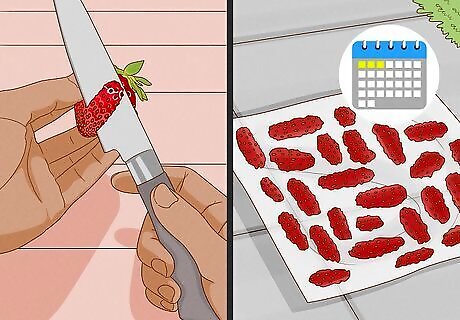
Peel the outer layer of a strawberry and dry it in the sun to collect seeds. To get strawberry seeds from home-grown or store-bought berries, cut off the top layer of skin containing the tiny, yellow seeds with a knife. Then, lay the peels on a paper towel and dry them in the sun for 2 to 3 days. Simply rub the strawberry skins to loosen the seeds and collect them in a bowl. Most store-bought strawberries are hybrids of several different varieties. The fruit from their seeds tends to be smaller than the berries you buy in the store. If you don’t want to collect your own seeds, use strawberry seed packets. Strawberries come in 3 varieties: June-bearing, everbearing, and day-neutral. June-bearing berries produce a single harvest in mid-summer while everbearing and day-neutrals produce fruit throughout the summer and fall. If you’re growing your strawberries in containers, day-neutral or everbearing are the best options.
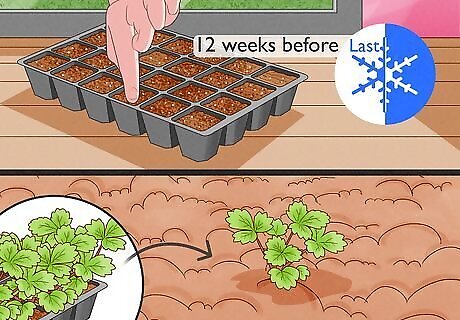
Plan to start strawberry seeds 12 weeks before your area’s last frost. The last frost date is typically the last day in spring when your area experiences freezing weather. Starting your seeds 12 to 16 weeks before this date allows your seeds to sprout and be ready for transplanting as soon as the weather is warm. Search for your area’s last frost date online. Or, find the date using a last freeze map if you live in the US.
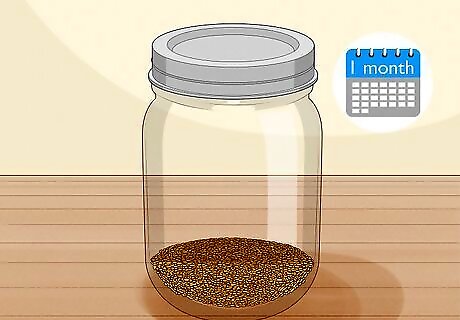
Refrigerate the seeds for 4 to 6 weeks to speed up germination. In the wild, the cold, winter weather signals to strawberry seeds that it’s almost time to sprout. To mimic this process, which is called cold stratification, pour your seeds into an air-tight storage container. Then, set the container in your fridge for about 1 month. If you’re using a seed packet, simply set the pack in the fridge. For faster cold stratification, freeze the seeds for 2 weeks. Strawberry seeds still germinate if you don’t put them in the fridge. Your seeds might just take longer to sprout.
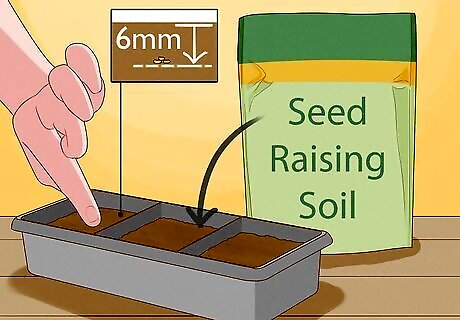
Thaw the seeds and sow them in trays filled with moist seed starting mix. Take your seeds out of the fridge or freezer and leave them in their container to warm up to room temperature. Then, fill a seed tray with seed starting mix and water the soil. Place 2 to 3 strawberry seeds on top of each cell in the tray and gently press them about 6 mm (0.24 in) into the soil.
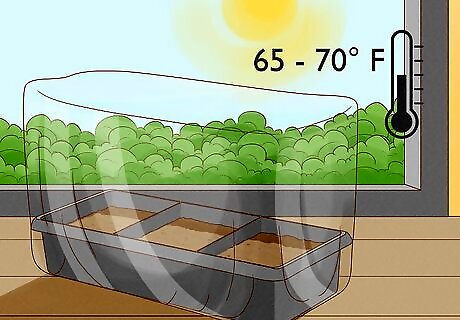
Cover the tray with plastic wrap and set it in a warm, sunny spot. To trap in moisture and keep the seeds hydrated, place plastic wrap, a plastic bag, or a sheet of glass over the seed tray. Then, place your seeds in a bright spot indoors, like a windowsill, that gets plenty of sunlight in the morning. If you don’t have a sunny spot in your home, place a grow light 2 inches (5 cm) above the seeds. Strawberry seeds germinate the best at temperatures between 65 to 70° F (18-21° C). If you live in a cooler area, place a heat mat underneath the tray.
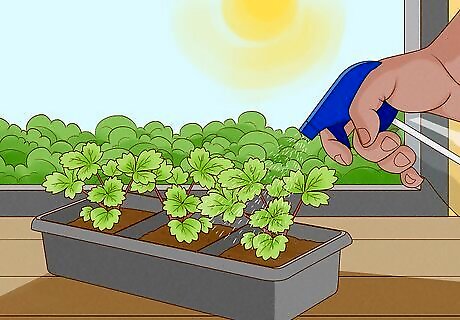
Take off the cover and keep the soil moist once the seeds sprout. It typically takes 1 to 6 weeks for strawberry seeds to germinate and sprout out of the soil. When you see the little green seedlings, take off the plastic cover over the tray. Then, monitor the soil moisture by sticking your finger 1 inch (2.5 cm) deep into the dirt. If the soil is dry, mist the seedlings with water.
Transplanting Strawberry Seedlings
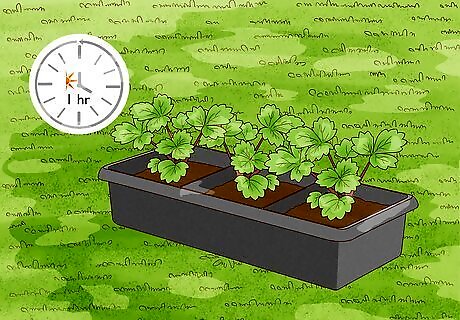
Harden off the seedlings when they have 2 to 3 sets of true leaves. Slowly acclimate, or harden off, your strawberry seedlings to outdoor conditions before you plant them in your garden or in containers. Start by setting your seed tray outside in partial sun for 1 hour. Then, gradually increase the amount of sun the seedlings get over the course of 1 week. True leaves are the leaves that grow after the 2 round seed leaves that sprout from the seedling. Hardening off is an important process that prevents your seedlings from being shocked or damaged by outdoor conditions.

Pick a spot outside that gets full sun and has well-draining soil. Strawberries thrive when they receive at least 6 hours of direct sunlight. They are also sensitive to moisture and don’t like for their roots to stay wet. So, make sure the sunny spot is also full of sandy loam soil that drains well. Check that your soil drains well by digging a hole that’s 12 in (30 cm) wide and deep. Then, fill the hole with water. If it drains in less than 10 minutes, your soil is well-draining. If your soil doesn’t drain well, add compost, peat moss, or decomposed manure to your planting area.
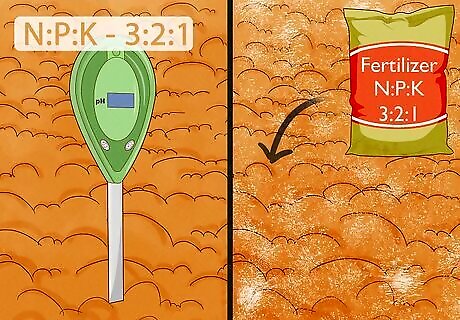
Test the soil to see if it needs any nutrients. Use a soil testing kit to see if your soil is well-balanced with nitrogen, phosphorus, and potassium (NPK). If your soil needs adjustments, the test gives you the NPK ratio that your soil needs. Then, add a fertilizer that matches the recommended NPK ratio to the soil. For instance, if your test results recommended an NPK ratio of 3-1-2, use a fertilizer with a 3-1-2 NPK ratio on the label. Many experts advise applying a balanced fertilizer, like 10-10-10 NPK, to the soil before you plant. Just add 1 lb (0.45 kg) of fertilizer for every 100 sq ft (9.3 m) of plants and work it about 6 to 8 in (15 to 20 cm) into the dirt.
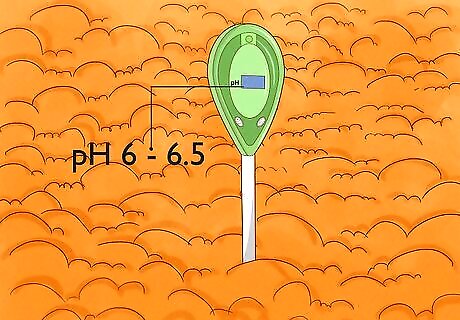
Adjust the soil pH between 6.0 and 6.5, if necessary. Use your soil testing kit to check the pH of your garden. If the soil pH is very acidic, or below 6.0 pH, spread granular or pulverized agricultural lime over the damp soil about 2 to 3 months before you plant. If the soil pH is very basic, or above 6.5 pH, apply aluminum sulfate or sulfur over your soil instead. The amount of lime, sulfate, or sulfur you need depends on the pH of your soil. Use a pH adjustment graph to find out how much you need.
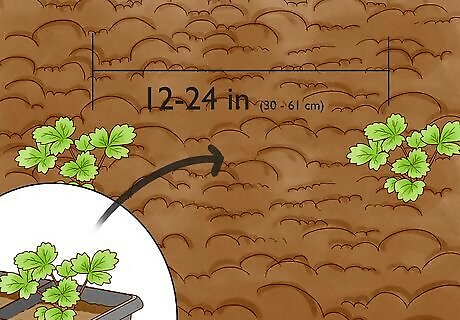
Plant the seedlings in rows about 12 to 24 inches (30-61 cm) apart. To give your strawberry plants plenty of space to grow, space them about 12 to 24 inches (30-61 cm) apart, depending on the variety. Just dig a hole deep enough to bury the roots beneath the ground, making sure that the crown, or base of the plant, is not buried. For June-bearing strawberries: space them 12 to 24 in (30-61 cm) apart. For day-neutral strawberries: space them 8 to 12 in (20-30 cm) apart. For everbearing strawberries: space them 12 in (30 cm) apart.
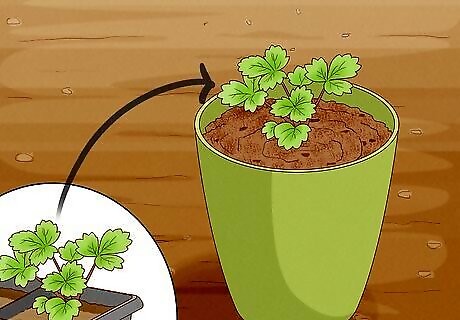
Grow the seedlings in containers if you don’t have room in your garden. Strawberries grow well in all sorts of containers. Just choose a pot, hanging basket, or window box with drainage holes that’s at least 8 inches (20 cm) wide. Fill the pot with loose, loamy potting soil that’s well-draining. Then, dig a hole in the center that’s deep enough to bury the roots of the plant. Plant a single strawberry plant in each container if you’re using regular pots. Strawberry jar planters and trug planters, which are raised, table-like planters, can hold about 8 strawberry plants in 1 container. Hanging baskets can hold about 6 strawberry plants, while window boxes can hold about 4.
Strawberry Care & Harvesting
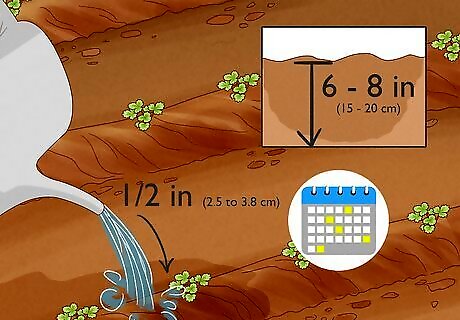
Water your strawberries weekly, or when the soil is dry. In general, strawberries need about 1 to 1 ½ inches (2.5-3.8 cm) of water each week. To tell if the soil is dry, poke your finger about 1 inch (2.5 cm) deep into the dirt. If it feels dry, give your plants a good soaking. If it rains pretty frequently in your area, only water your plants when the soil is dry.
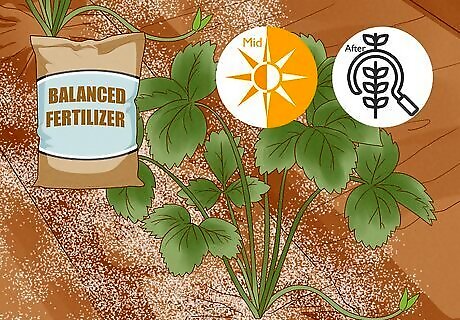
Fertilize your plants mid-summer and after the final harvest. For most varieties of strawberries, feed them twice during the growing season with a balanced fertilizer. Either water your plants with a water-soluble fertilizer or sprinkle a solid fertilizer across the soil. Some experts recommend scattering a general fertilizer over your plants in the early spring, and nourishing them with a liquid tomato fertilizer every 1-2 weeks throughout the growing season.
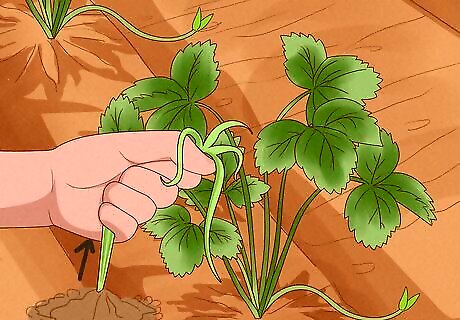
Pull out weeds when you notice them. Regularly monitor your strawberry plant for weeds. When you see any, simply pull them out with your hands. Strawberries don’t have a deep root system, so a hoe or other tool might hurt the plant. To deter weeds from growing, spread a thick layer of straw mulch around your strawberries.
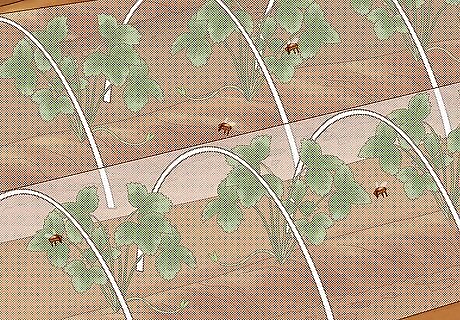
Get rid of pests and diseases with fungicides, bait, and other remedies. Strawberries are hardy plants that aren’t susceptible to a lot of pests or diseases. If you notice any mold growing on your plants, spritz them with fungicide. To deter pests like slugs or spotted wing drosophila, place slug bait and insect traps near the strawberries. If you notice gray mold developing on your plants, cut off the affected leaves and vines as soon as possible. Alternatively, use citrus rinds to repel slugs away from your plants. Drape a garden net over your strawberries to prevent birds and other animals from nibbling the strawberries.
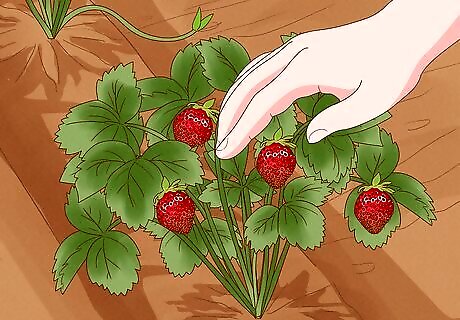
Pick your strawberries when they’re completely red. Most strawberries ripen 30 days after the flowers bloom. Simply snip off the berries from the stem with scissors, or pluck them off with your hands. Just pick them after the morning dew evaporates for an especially fresh and delicious taste. Eat or cook with your strawberries as soon as possible; this fruit doesn’t do well in the freezer. Strawberry plants typically produce fruit for about 3 years.
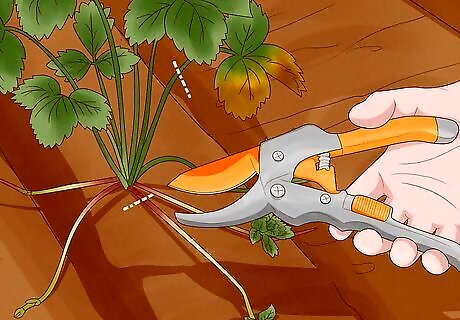
Prune off runners and damaged leaves. Runners are long, horizontal stems that your plant shoots out that eventually turn into new strawberry plants. If any runners are overwhelming your garden or container, prune them back with clean shears or scissors. Then, routinely check your plants for any yellow or browning leaves and snip them off. In the first year of growth, prune off any runners you see so they don’t take energy away from your growing plant. When your strawberry plant stops producing fruit, simply snip off a runner that has a new plant growing from it. Then, plant the runner in a pot.

















Comments
0 comment